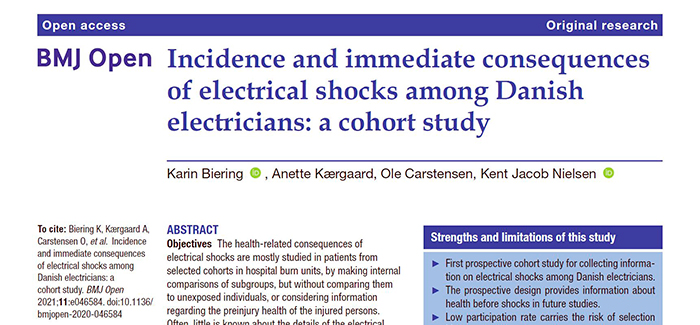Nearly one-fourth of Danish electricians experienced one or more electrical shocks during a 26-week period, but most of the shocks are not perceived as severe, and have only limited immediate consequences.

Karin Biering, Anette Kargaard, Ole Carstensen, Kent Jacob Nielsen
Abstract
Objectives: The health-related consequences of electrical shocks are mostly studied in patients from selected cohorts in hospital burn units, by making internal comparisons of subgroups, but without comparing them to unexposed individuals, or considering information regarding the preinjury health of the injured persons. Often, little is known about the details of the electrical shocks. Our purpose was to do a longitudinal study of Danish electrical workers, to monitor exposure to electrical shocks weekly over a 6-month period and to determine whether these shocks have short-term, health-related consequences.
Design: Prospective cohort study with weekly measurements.
Setting: Members of the Danish Union of Electricians.
Participants: Of the 22 284 invited, 6960 electricians (31%) participated in the baseline data collection, and the participation rate in the weekly follow-up ranged from 61% to 81% during the 6 month follow-up.
Primary and secondary outcome measures: The primary outcome measure was an electrical shock and secondary outcomes were the immediate health-related consequences of the shocks.
Results: A total of 2356 electrical shocks were reported by 1612 (23%) of the participants during the 26-week follow-up. Alternating current and voltage below 1000 V were the most common forms of electricity. In most cases, the fingers/hands were the entry and exit points, but many were unable to specify the exit point. The participants categorised 73% of the electrical shocks as ‘not at all severe’, and most of the shocks did not cause any immediate physical damage. However, flashbacks were more common than physical consequences. Only a few of the participants contacted health services following an electrical shock, and even fewer were absent from work.
Conclusion: Nearly one-fourth of Danish electricians experienced one or more electrical shocks during a 26-week period, but most of the shocks are not perceived as severe, and have only limited immediate consequences.
Download den videnskabelige artikel, publiceret i BMJ Open, Vol. 11, nr. 8, juli 2021:
